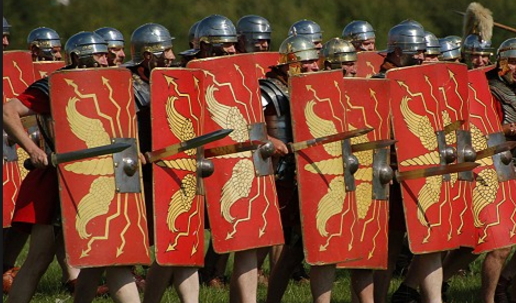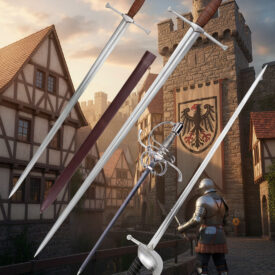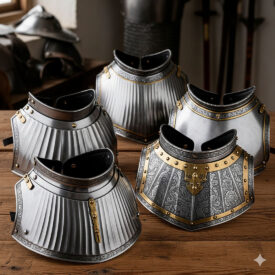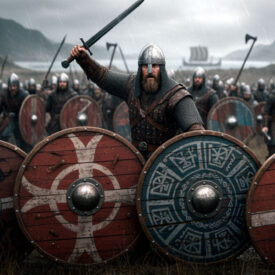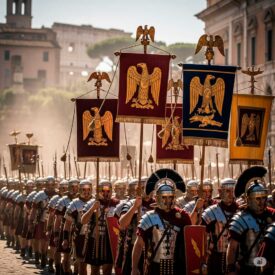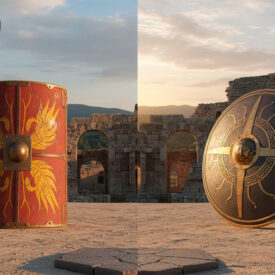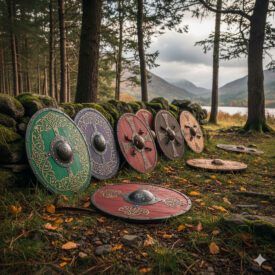Roman Shield and Scutum: few pieces of military equipment define the identity of the Roman legion as well as this semi-cylindrical shield. In this article, you will discover what exactly a scutum is, how it was built, why it was key in Roman formations, and how those ancient solutions are translated into modern replicas available in our online store.
If you have a text you want to clean or adapt, paste it and we will process it to return only the main content respecting the original structure, titles and format; this same philosophy of preserving the essential is applied to the study of the Roman shield (scutum) throughout this article.
What is the Scutum? Origin and concept
The term scutum is the Latin word for the typical Roman shield used by legionaries. Its slightly curved or semi-cylindrical shape is no coincidence: it responds to a mixture of protection, ergonomics and offensive functionality. Broadly speaking, a scutum covers the legionary from shoulder to knee, allowing individual and collective protection in formation.
Design and parts of the shield
A scutum is made up of several key parts:
- Curved coverage: allows impacts to be distributed and creates a continuous front when shields overlap.
- Umbo: the central boss, generally made of a copper or brass and iron alloy, which protects the hand and serves as an offensive component.
- Reinforced edges: often lined with metal to resist cuts and blows.
- Handles and straps: designed to ensure grip and allow offensive maneuvers with the shield.
The umbo was especially important: a convex metal piece screwed to the center that absorbed the impact and, at the same time, could be used to dent or stun the opponent. Thanks to this configuration, the shield was not only defensive but also an auxiliary weapon.
Construction and materials: ancient solutions and modern replicas
The classic scutum was made of plywood boards or glued strips, covered with linen or leather, and with a central metal umbo. The edges could carry iron or bronze sheets to reinforce the structure. Modern replicas use variants such as varnished wood, EVA foam, latex, or combinations that seek a balance between authenticity and use in recreation or LARP.
As a reference, today you will find:
- Functional replicas in wood and metal, designed for collecting and serious recreation.
- Light models in foam or latex, designed for LARP or safe training.
- Decorative shields for exhibitions or historical decoration.
Tactics and formations: how the scutum turned the legion into a war machine
The curvature of the scutum and its size allowed legionaries to form continuous fronts where surface painting mattered less than cohesion. Two notable maneuvers:
- Closed line formation: the shields overlapped laterally, covering gaps and offering individual and group protection.
- Testudo (turtle): legionaries placed vertical shields in front and horizontal shields over their heads, creating an almost impenetrable cover against arrows and objects thrown from walls.
The effectiveness of these formations depended not only on the material of the shield, but on the training, discipline, and synchronization of the troops. The scutum adapted perfectly to these needs and became an identifying element of the legion.
Offensive use and hand-to-hand tactics
Although at first glance the Roman shield seems purely defensive, its design allowed for combined use: with the scutum slightly raised, the legionary blocked attacks and immediately advanced with his gladius. The umbo served to push, strike, and destabilize the enemy, creating openings for the next attack.
The metallic edges of the shield allowed for powerful cuts and blows, and some archaeological records and representations show aggressive maneuvers based on the shield as the primary contact tool.
Size and ergonomics: why the scutum covered from shoulder to knee
The “standard” size of the scutum, from the shoulder to approximately the upper knee, was a solution designed to balance protection and mobility. This measure covered most of the torso and thigh, but left enough freedom for handling the sword and speed of movement.
In addition, in a closed formation, each shield partially covered the companion, creating a mobile wall that protected collectively more than individually.
Historical variants of the Roman Shield
Throughout Roman history, there were notable variants of the scutum and other related shields:
- Imperial Scutum: more common in the Imperial era, with deep curvature and larger size.
- Republican Scutum (Mainz): somewhat different shapes found in sites such as Mainz, with decorations and variations in the umbo.
- Parma: smaller, round shields used by cavalry.
These differences are due to tactical changes, material availability, and regional preferences. When choosing a replica, think about what you need it for: decoration, recreation, or LARP.
Comparison table: Scutum types and modern replicas
| Model | Material | Typical Size | Recommended Use | Estimated Price |
|---|---|---|---|---|
| Imperial Scutum | Plywood, canvas or leather covered, metal umbo | 100×60 cm (approx.) | Historical reenactment and collecting | 120€ – 210€ |
| Republican Scutum (Mainz) | Wood, metal reinforcements | Variable, similar to imperial | Archaeological reproductions | ~200€ |
| Turtle Scutum (Function Scutum) | Painted wood, metal umbo | 90×55 cm | Formations, recreation | 150€ – 210€ |
| Foam/LARP Scutum | EVA, latex, injected foam | 90-100×50-65 cm | LARP, events, safety | 120€ – 180€ |
| Round shield / Parma | Wood or metal | Ø 40-62 cm | Cavalry, gladiators | 70€ – 290€ |
Care, maintenance and conservation of a scutum
If you have a wooden replica, protect it from humidity and sudden changes in temperature. A varnish or a layer of oil on the wooden edge helps prevent deformation. The metal umbo needs cleaning and protection against corrosion.
For latex or foam shields, check the condition of the coating and repair small cracks with specific latex products; this extends their life and maintains their aesthetic.
Reproductions and models in our store
In our online store we offer a wide selection of Roman shields and scutum in different ranges: from display pieces to shields designed for historical reenactment and LARP. If you are looking for authenticity, we have wooden models with a metal umbo; if your priority is lightness and safety, we also have scutum in foam or latex for events.
Tips for choosing your shield
Consider these factors when choosing a Roman shield:
- Intended use: decoration, recreation or LARP.
- Material: wood for authenticity, foam/latex for safety.
- Size: do you prefer full coverage or mobility?
- Budget: functional replicas are usually more expensive than foam ones.
If you need specific advice on which model best suits your expectations, contact our team in the online store and we will guide you.
The legacy of the Scutum in material culture
The Roman shield was not only a tool of war: it is a symbol of the discipline, technical ingenuity, and organization that allowed Rome to project power for centuries. In museums and private collections, the forms of the scutum continue to arouse interest among historians, artisans, and reenactors.
Today, making a replica is both an exercise in historical reconstruction and a creative opportunity to adapt a classic military solution to contemporary uses: shows, exhibitions, training, and entertainment.
VIEW ROMAN SCUTUM | VIEW OTHER HISTORICAL SHIELDS
Knowledge of the Scutum reminds us that every military element responds to a strategic need. From the metal umbo to the curvature designed to fit with a companion’s shield, the Roman shield is a lesson in functional design. If you are looking for a replica, in our online store you will find models for every use and budget.


